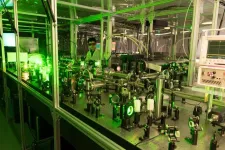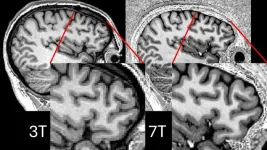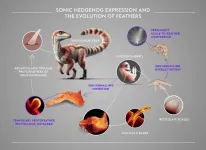(Press-News.org) A research team led by Colorado State University has achieved a new milestone in 3D X-ray imaging technology. The scientists are the first to capture high-resolution CT scans of the interior of a large, dense object – a gas turbine blade – using a compact, laser-driven X-ray source.
The findings, published this week in Optica, describe the science and engineering behind this new radiographic imaging capability and its potential benefits to a range of industries, from aerospace to additive manufacturing.
The project is a years-long collaboration between researchers at CSU’s Departments of Electrical and Computer Engineering and Physics and Los Alamos National Laboratory, with participation from AWE in the U.K.
“This demonstration is just the beginning,” said Reed Hollinger, an assistant professor at CSU and lead author of the study. “We are using the CSU-built ALEPH laser to generate extremely bright X-ray sources to do high-resolution X-ray radiography and CT. As we develop our new facility, our goal is to ramp this into something that can make a broad impact.”
The team’s approach offers a fast and non-destructive way to obtain a detailed view inside dense structures, such as rocket components and turbojet engines. With growth in additive manufacturing, the new technology could greatly enhance quality control while preserving the integrity of 3D-printed parts.
Next-generation laser-driven imaging at Colorado State University
Current industrial CT scanners are not only massive and costly, but they produce images with millimeter scale resolution. The team’s laser-driven approach generates a much smaller X-ray source, enabling significantly higher resolution without decreasing the energy of the X-rays.
“A small spot MeV X-ray source is the single largest lever that is potentially available for improving high resolution MeV X-ray imaging,” said James Hunter of Los Alamos National Laboratory, who collaborated with Hollinger on the study.
The method, rich in physics, uses a petawatt class laser focused to an intensity of 1021 Wcm-2 to accelerate a beam of electrons to a few million volts over a few microns in space – smaller than the width of a human hair. The electrons in the beam collide with heavy atoms in the target, causing them to slow down and convert their kinetic energy to X-rays. These X-rays have significantly higher energy than those found in traditional X-ray tubes used in hospitals. The increased X-ray energy is necessary to penetrate dense objects like the turbine blades shown in the study.
“For perspective, the energy of a traditional hospital X-ray source is only tens of thousands of volts as opposed to our X-ray source, which is millions of volts,” said Hollinger, who is part of the Walter Scott, Jr. College of Engineering at CSU.
Each X-ray pulse only lasts for a few trillionths of a second, enabling time-resolved radiography of objects moving at incredible speeds.
“For example, we could one day capture high-resolution 3D images of the inside of a jet engine while it’s operating. Currently, there are no other X-ray sources that can do this,” said Hollinger.
The CSU team’s work is part of a larger vision to leverage high-intensity laser sources for a wide range of uses, from studying inertial fusion energy to generating bright beams of GeV electrons and MeV x-rays. It is one of the many technologies that researchers aim to scale up using the expanded capabilities of the university's new Advanced Technology Lasers for Applications and Science (ATLAS) Facility, set to come online in late 2026.
END
Researchers capture first laser-driven, high-resolution CT scans of dense objects
A Colorado State University team has achieved a new milestone in 3D X-ray imaging technology
2025-03-20
ELSE PRESS RELEASES FROM THIS DATE:
Cambridge team uses powerful new MRI scans to enable life-changing surgery in first for adults with epilepsy
2025-03-20
A new technique has enabled ultra-powerful magnetic resonance imaging (MRI) scanners to identify tiny differences in patients’ brains that cause treatment-resistant epilepsy. In the first study to use this approach, it has allowed doctors at Addenbrooke’s Hospital, Cambridge, to offer the patients surgery to cure their condition.
Previously, 7T MRI scanners – so called because they operate using a 7 Tesla magnetic field, more than double the strength of previous 3T scanners – have suffered from signal blackspots in crucial parts of the brain. But in research ...
NRL's narrow field imager launches on NASA's PUNCH mission
2025-03-20
WASHINGTON, D.C. — The U.S. Naval Research Laboratory’s (NRL) Narrow Field Imager (NFI) was launched into space aboard a SpaceX Falcon 9 rocket as a part of NASA’s Polarimeter to Unify the Corona and Heliosphere (PUNCH) mission on March 11 and deployed from Falcon 9 on March 12.
PUNCH is a four-satellite constellation, collecting observations in low Earth orbit. It will conduct global, 3D observations of the inner heliosphere to investigate the solar corona's evolution into the solar wind. The mission is scheduled to conduct science for the next two years, following a 90-day commissioning period.
The NRL-developed NFI, sponsored ...
Galapagos birds exhibit ‘road rage’ due to noise
2025-03-20
A new study has discovered that birds in the Galápagos Islands are changing their behaviour due to traffic noise, with those frequently exposed to vehicles showing heightened levels of aggression.
Published in the journal Animal Behaviour and led by experts from Anglia Ruskin University (ARU) and the Konrad Lorenz Research Centre at the University of Vienna, the research examined the impact of vehicle noise pollution on Galápagos yellow warblers (Setophaga petechia aureola), a songbird widespread on the archipelago.
The Galápagos Islands, ...
Groundbreaking study finds AI-driven interviews with children may boost accuracy in witness accounts
2025-03-20
Groundbreaking Study Finds AI-Driven Interviews with Children May Boost Accuracy in Witness Accounts
In a first-of-its-kind study published in the journal PLOS ONE, an international team of researchers led by scholars from New York University Shanghai and Åbo Akademi University in Turku, Finland explored the potential of artificial intelligence to assist in sensitive child investigative interviews. The study compared how effectively a Large Language Model (LLM), specifically ChatGPT, and untrained human interviewers were able to interview children about a mock event ...
New framework to measure economic well-being considers new and free goods and services; addition of digital goods boosts growth
2025-03-20
Welfare measurement is among the most fundamental questions in economics. Policymakers and others use gross domestic product (GDP) as a proxy for welfare, but this application does not reflect the benefits of introducing new and free goods and services, such as digital goods, and may result in misunderstanding the economy.
In a new study, researchers developed a framework to measure the welfare contributions of new and free goods and services and quantify their benefits. By applying the framework to several examples (e.g., Facebook, Smartphone cameras), the study found that these goods and services significantly increase welfare.
The study ...
Augmented reality guidance for placing intracranial drains now clinically validated
2025-03-20
March 20, 2025 — Placing an external ventricular drain (EVD) at bedside using augmented reality (AR) guidance is more precise than freehand placement and is associated with fewer reinterventions and complications, according to a clinical pilot study of a novel system. Frederick Van Gestel, MD, a neurosurgery resident at Universitair Ziekenhuis Brussel and PhD researcher at Vrije Universiteit Brussel in Brussels, Belgium, and colleagues report first-in-human results in Neurosurgery, the official publication of the Congress ...
How feathers develop in chickens
2025-03-20
Inhibiting the sonic hedgehog (Shh) pathway strongly perturbs feather development in chickens by restricting feather bud outgrowth, invagination and branching, according to a study published March 20th, in the open-access journal PLOS Biology by Rory Cooper and Michel Milinkovitch from the University of Geneva, Switzerland.
Avian feathers are intricate appendages whose forms vary substantially across species and body areas, and between juvenile and adult stages. Understanding both the developmental and evolutionary mechanisms underpinning this morphological diversity has long fascinated biologists. The morphological intricacies ...
Insomniac fruit fly mutants show enhanced memory despite severe sleep loss
2025-03-20
Fruit fly mutants that have severe sleep deficits perform better at olfactory learning and memory tasks, according to a study published March 20th in the open-access journal PLOS Biology by Sheng Huang and Stephan Sigrist from Freie Universität Berlin, Germany, and colleagues. The paradox of enhanced memory despite sleep loss could be explained by protein kinase A (PKA) signaling in the mushroom body of the fly brain.
Sleep is a dynamic process conserved from invertebrates to mammals and humans. Although sleep is thought to serve many purposes, it is often studied for its restorative roles, which ...
Seals can sense their own circulating blood oxygen and it keeps them from drowning
2025-03-20
Marine mammals may have a secret weapon to survive long dives – an ability to directly sense their own circulating blood-oxygen levels that most mammals lack – allowing them to stay submerged longer and resurface before hypoxia leads to drowning, researchers report. Air-breathing marine mammals have developed a range of physiological adaptations to survive in aquatic environments, including thermoregulation to endure the pressures of the deep. However, one of the most critical evolutionary challenges for diving mammals is avoiding drowning. Despite adaptations for larger oxygen storage and tolerance to low oxygen levels, these animals still risk drowning if they ...
Infants encode short-lived hippocampal memories
2025-03-20
Challenging assumptions about infant memory, a novel functional magnetic resonance imaging (fMRI) study shows that babies as young as 12 months old can encode memories, researchers report. The findings suggest that infantile amnesia – the inability to remember our first few years of life – is more likely caused by memory retrieval failures rather than an inability to form memories in the first place. Despite infancy being a period of rapid learning, memories from this time do not persist into later childhood or adulthood. In ...
LAST 30 PRESS RELEASES:
New study overturns long-held model of how plants coordinate immune responses.
New AI model predicts disease risk while you sleep
Scientists discover molecular ‘reshuffle’ and crack an 80-year-old conundrum
How stressors during pregnancy impact the developing fetal brain
Electrons lag behind the nucleus
From fungi to brain cells: one scientist's winding path reveals how epigenomics shapes neural destiny
Schizophrenia and osteoporosis share 195 genetic loci, highlighting unexpected biological bridges between brain and bone
Schizophrenia-linked genetic variant renders key brain receptor completely unresponsive to both natural and therapeutic compounds
Innovative review reveals overlooked complexity in cellular energy sensor's dual roles in Alzheimer's disease
Autism research reframed: Why heterogeneity is the data, not the noise
Brazil's genetic treasure trove: supercentenarians reveal secrets of extreme human longevity
The (metabolic) cost of life
CFRI special issue call for papers: New Frontiers in Sustainable Finance
HKU Engineering scholar demonstrates the smallest all-printed infrared photodetectors to date
Precision empowerment for brain "eavesdropping": CAS team develops triple-electrode integrated functional electrode for simultaneous monitoring of neural signals and chemical transmitters during sleep
Single-capillary endothelial dysfunction resolved by optoacoustic mesoscopy
HKU three research projects named among ‘Top 10 Innovation & Technology News in Hong Kong 2025’ showcasing excellence in research and technology transfer
NLRSeek: A reannotation-based pipeline for mining missing NLR genes in sequenced genomes
A strand and whole genome duplication–aware collinear gene identification tool
Light storage in light cages: A revolutionary approach to on-chip quantum memories
Point spread function decoupling in computational fluorescence microscopy
BacPhase: Long-insert paired-end sequencing for bin marker construction and genome phasing
GmWOX1 regulates the mediolateral polarity of compound leaves in soybean
ChargeFabrica: An open-source simulation tool that aims to accelerate search for high performance perovskite solar cells
High levels of ADAR overexpression induce abundant and stochastic off-target RNA editing in rice protoplasts
On-demand upgraded recycling of polyethylene and construction of sustainable multifunctional materials based on the "LEGO" strategy
New "Stomata in-sight" system allows scientists to watch plants breathe in real-time
Anorexia nervosa may result in long-term skeletal muscle impairment
Narrative-based performance reviews deemed fairest by employees
New insights reveal how advanced oxidation can tackle emerging water pollutants
[Press-News.org] Researchers capture first laser-driven, high-resolution CT scans of dense objectsA Colorado State University team has achieved a new milestone in 3D X-ray imaging technology




